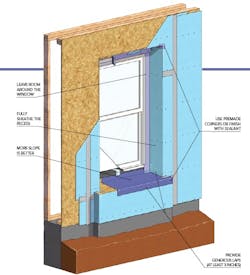When it comes to window flashing, the best advice is to use the same care as you would for a skylight. That’s especially true for recessed or pot-shelf windows. If the flashing is less than perfect, water that puddles on the sill of the recess can quickly seep into the structure.
Recessed windows are most common in stucco-clad homes in the Southwest. They’re meant to mimic traditional adobe houses whose thick walls necessitated such windows.
Know the Pitfalls
There are at least two ways to go about flashing this type of assembly. Most effective is to use a liquid-applied flashing. On such a complex window, liquid flashings can do a very good job of getting into the corners.
The other method would be to use conventional flashing. The procedure for flashing such a window using conventional flashing is too complicated to present in a short column, so IBACOS has posted step-by-step instructions at the link provided at the end of this article. These instructions have proven themselves effective with several of our builder clients, so I recommend you study and follow them carefully.
There are basic mistakes that architects and installers make with recessed windows. Here are tips for avoiding them.
Leave room around the window. In many homes, there is only 2 or 3 inches of space between the window edge and the side of the recess—not enough for a good interface between flashing and water-resistive barrier (WRB). We recommend designing and framing the opening so that there is at least 6 inches of space.
More slope is better. You don’t want water puddling on that shelf. The deeper the recess, the steeper the slope required, but in no case should the shelf slope less than 5 degrees (or about 1 inch per foot).
Fully sheathe the recess. I see too many openings that are framed with OSB sheathing only on the sill of the recess and not on the sides or top. This is inadequate support for the flashing, making it difficult to do a good job. Fully sheathe the recess.
Use premade corners or finish with sealant. Unless your installer is a flashing genius, there’s a good chance that the origami required to flash the bottom outside corner of the recess will leave pinholes. And a pinhole is all it takes to start letting water into the structure. Manufacturers make prefabricated corner-flashing pieces for this application from materials that include rubber, modified asphalt, and plastic, and they provide the best way to protect such corners. An alternative would be to apply a good sealant to any potential pinholes that remain.
Use the correct sealant. The sealant needs to stay flexible for a long time, with enough UV resistance to handle a normal construction delay. Such sealants will meet the ASTM C920 Class 25 standard. There are lots of sealants, siliconized and non-siliconized, that make the grade, with the ASTM standard noted on the tube and manufacturer’s spec sheet.
Leave generous laps. Adequate shingle-style laps ensure that flashing sheds water. Unfortunately, I see many instances where the flashing membrane isn’t lapped far enough over the front edge of the recess or under the flashing and WRB at the sides. Don’t skimp on this detail.
Why be so obsessive about flashing in dry climates such as Arizona, Nevada, or New Mexico? While it doesn’t rain very often in those locations, even the occasional downpour is enough to start rotting the framing around a leaky flashing job. It will be hidden from sight until it’s a very expensive problem to fix.

